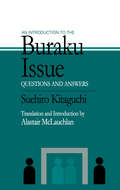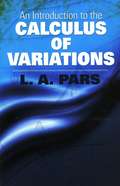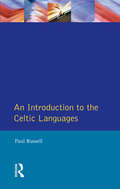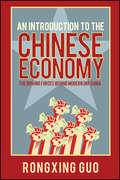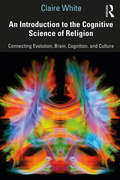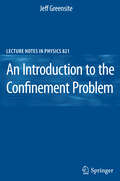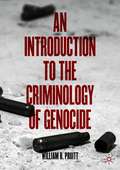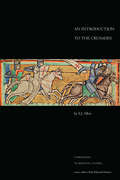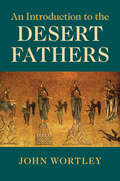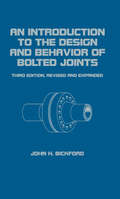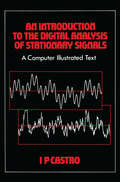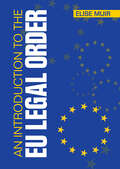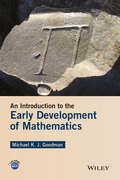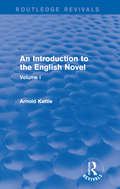- Table View
- List View
An Introduction to the Buraku Issue: Questions and Answers
by Suehiro Kitaguchi Alastair McLauchlanTranslated with an Intoduction by Alastair McLaughlin. The extent of discrimination against the Buraku communities is one of the most sensitive issues facing the Japanese government and the social coherence of contemporary Japan.
An Introduction to the Business of Tourism
by Venu Vasudevan B. VijayakumarThis textbook offers a lucid understanding of the business of tourism and helps students gain professional and entrepreneurial insights. An outcome of years of experience and practice, An Introduction to the Business of Tourism offers a fresh perspective of the skill-oriented, knowledge-based and multi-disciplinary arena of the tourism business. It presents a balanced mix of the basic principles and concepts, their application and policy implications as well as the business realities and operational aspects of the tourism industry. Divided into four sections and spread across nineteen chapters, this textbook delves deep into Indian and international tourism experiences with numerous integrated case studies and examples. Key Features: Special emphasis on recent business aspects of tourism from local and global perspectives Over 45 case studies to provide valuable insights into current business trends to strengthen the practical knowledge of students Each chapter has review questions and activities to support self-assessment. Book-end glossary of major concepts and terminologies to facilitate quick scan and easy understanding
An Introduction to the Calculus of Variations
by L. A. ParsThis clear, rigorous introduction to the calculus of variations covers applications to geometry, dynamics, and physics. Focusing upon problems with one independent variable, the text connects the abstract theory to its use in concrete problems. It offers a working knowledge of relevant techniques, plus an impetus for further study.Starting with an overview of fundamental problems and theories, the text advances to illustrative examples and examinations of variable end-points and the fundamental sufficiency theorem. Subsequent chapters explore the isoperimetrical problem, curves in space, the problem of Lagrange, and the parametric problem. The final chapter is devoted to multiple integrals, with a particular focus on Dirichlet's principle. Suitable for advanced undergraduate and graduate students, this text requires a background in mathematical analysis.
An Introduction to the Celtic Languages (Longman Linguistics Library)
by Paul RussellThis text provides a single-volume, single-author general introduction to the Celtic languages.The first half of the book considers the historical background of the language group as a whole. There follows a discussion of the two main sub-groups of Celtic, Goidelic (comprising Irish, Scottish, Gaelic and Manx) and Brittonic (Welsh, Cornish and Breton) together with a detailed survey of one representative from each group, Irish and Welsh.The second half considers a range of linguistic features which are often regarded as characteristic of Celtic: spelling systems, mutations, verbal nouns and word order.
An Introduction to the Chemistry of the Sea
by Michael E. Q. PilsonFully updated and expanded, this new edition provides students with an accessible introduction to marine chemistry. It highlights geochemical interactions between the ocean, solid earth, atmosphere and climate, enabling students to appreciate the interconnectedness of Earth's processes and systems and elucidates the huge variations in the oceans' chemical environment, from surface waters to deep water. Written in a clear, engaging way, the book provides students in oceanography, marine chemistry and biogeochemistry with the fundamental tools they need for a strong understanding of ocean chemistry. Appendices present information on seawater properties, key equations and constants for calculating oceanographic processes. New to this edition are end-of-chapter problems for students to put theory into practice, summaries to allow easy review of material and a comprehensive glossary. Supporting online resources include solutions to problems and figures from the book.
An Introduction to the Chinese Economy: The Driving Forces Behind Modern Day China
by Rongxing GuoThis comprehensive overview of the modern Chinese economy by a noted expert from China offers a quality and breadth of coverage. In this book, the author provides an introduction to China's economy since 1949 and original insights based on his own extensive research. The book sets out to analyze and compare the operational mechanisms of the Chinese economy between the pre- and post-reform periods and through national, regional and local dimensions. Both positive and negative consequences of the Chinese economic transformation have been clarified. A multiregional comparison of the Chinese economy is conducted in terms of natural and human resources, institutional evolution, as well as economic and social performances. At last, some key issues relating to the inherent operational mechanisms of and the dynamic patterns of the Chinese economy are also discussed.
An Introduction to the Cognitive Science of Religion: Connecting Evolution, Brain, Cognition and Culture
by Claire WhiteIn recent decades, a new scientific approach to understand, explain, and predict many features of religion has emerged. The cognitive science of religion (CSR) has amassed research on the forces that shape the tendency for humans to be religious and on what forms belief takes. It suggests that religion, like language or music, naturally emerges in humans with tractable similarities. This new approach has profound implications for how we understand religion, including why it appears so easily, and why people are willing to fight—and die—for it. Yet it is not without its critics, and some fear that scholars are explaining the ineffable mystery of religion away, or showing that religion is natural proves or disproves the existence of God. An Introduction to the Cognitive Science of Religion offers students and general readers an accessible introduction to the approach, providing an overview of key findings and the debates that shape it. The volume includes a glossary of key terms, and each chapter includes suggestions for further thought and further reading as well as chapter summaries highlighting key points. This book is an indispensable resource for introductory courses on religion and a much-needed option for advanced courses.
An Introduction to the Comparative Study of Private Law
by James Gordley Arthur Taylor von MehrenThis collection of readings sets out the two fundamental distinctions between common and civil law, namely that the former originated in the English courts, the latter in the Roman legal tradition, and that the common law is based on judicial decisions whereas codes form the basis of modern civil law. The core of book consists of cases, statutes and code provisions shaping the doctrines central to the law of property, tort, contract and unjust enrichment in the United States, England, France and Germany. These materials provide a road map of the law of each, allowing the reader to consider how doctrines differ, how these differences emerged, and whether the underlying problems and solutions are common to all. They also allow for comparison to be made between the approaches of common and civil law, and to consider the extent to which they depend on the origin and nature of the law.
An Introduction to the Comparative Study of Private Law: Readings, Cases, Materials
by James Gordley Hao Jiang Arthur Taylor von MehrenThis collection of readings places side by side the principal doctrines of contracts, torts, unjust enrichment, and property in the cases of the United States, England, France, Germany and China. It presents code provisions, cases, and other legal materials that describe the law in force, and places each doctrine in its historical context to enable an understanding of the development of law as an ongoing process, in which the resolution of current issues depends upon how past issues were resolved. It both provides a road map of the private law of these jurisdictions, and illustrates how private law has been shaped by history, by the effort to solve common problems, and by differences in culture. This new edition reflects changes in the law, and includes the addition of Chinese Law as a comparative study.
An Introduction to the Confinement Problem (Lecture Notes in Physics #821)
by Jeff GreensiteThis book addresses the confinement problem, which quite generally deals with the behavior of non-abelian gauge theories, and the force which is mediated by gauge fields, at large distances. The word "confinement" in the context of hadronic physics originally referred to the fact that quarks and gluons appear to be trapped inside mesons and baryons, from which they cannot escape. There are other, and possibly deeper meanings that can be attached to the term, and these will be explored in this book. Although the confinement problem is far from solved, much is now known about the general features of the confining force, and there are a number of very well motivated theories of confinement which are under active investigation. This volume gives a both pedagogical and concise introduction and overview of the main ideas in this field, their attractive features, and, as appropriate, their shortcomings.
An Introduction to the Confinement Problem (Lecture Notes in Physics #972)
by Jeff GreensiteThis book addresses the confinement problem, which concerns the behavior of non-abelian gauge theories, and the force which is mediated by gauge fields, at large distances. The word “confinement” in the context of hadronic physics originally referred to the fact that quarks and gluons appear to be trapped inside mesons and baryons, from which they cannot escape. There are other, and possibly deeper meanings that can be attached to the term, and these will be explored in this book. Although the confinement problem is far from solved, much is now known about the general features of the confining force, and there are a number of very well motivated theories of confinement which are under active investigation. This volume gives a both pedagogical and concise introduction and overview of the main ideas in this field, their attractive features, and, as appropriate, their shortcomings. This second edition summarizes some of the developments in this area which have occurred since the first edition of this book appeared in 2011. These include new results in the caloron/dyon picture of confinement, in functional approaches, and in studies of the Yang-Mills vacuum wave functional. Special attention, in two new chapters, is given to recent numerical investigations of the center vortex theory, and to the varieties of confinement which may exist in gauge-Higgs theories. Reviews of the first edition: “This is indeed a very good book. I enjoyed reading it and… I learned a lot from it.… It is definitely a research book that provides readers with a guide to the most updated confinement models.” (Giuseppe Nardelli, Mathematical Reviews, Issue 2012 d) “The book is beautifully produced with special emphasis on the relevance of center symmetry and lattice formulation as well as an introduction to current research on confinement.” (Paninjukunnath Achuthan, Zentralblatt MATH, Vol. 1217, 2011)
An Introduction to the Criminology of Genocide
by William R. PruittThis textbook provides an accessible and interdisciplinary introduction to genocide with an emphasis on the criminal aspect of genocide. It draws on sociological, political, and historical concepts to discuss how they contribute to our understanding of genocide as an international crime. It walks students through the evolution of genocide as a criminal act and the legal responses available using case studies to demonstrate how concepts work in action. It combines Criminology and Law, arguing that Criminology can help explain the ‘why and how’ while Law can explain the responses to crime. This textbook includes a chapter on genocide denial as well as discussion questions at the end of the chapters, boxed examples, and further reading. It speaks to students in Criminology, Law, Socio-Legal Studies, and beyond, as well as to practitioners in the criminal justice field.
An Introduction to the Crusades (Companions To Medieval Studies)
by S. J. AllenAn Introduction to the Crusades, part of the Companions to Medieval Studies series, is an accessible guide to studying the complex history of the Crusades. The book begins by defining the Crusades, giving the political and social context of Byzantium, Western Europe, the Islamic States, and Jewish communities to set the scene for crusading from the eleventh century to the end of the medieval period. It then immerses the reader in the logistics of crusading and the day-to-day life of a crusader, explaining arms and armor, strategy and tactics, and siege warfare. Topics explored in depth include women on crusade, pilgrimage, the Mongols, crusade charters, and the use of crusader rhetoric throughout history. A case study chapter on the negotiations for Jerusalem between Saladin and Richard I provides insight into the process of historical inquiry and methods for engaging with primary sources. The book is pedagogically grounded through the inclusion of questions for reflection, sixteen images, four maps, a detailed chronology, a glossary, a "Who's Who" of the crusading world, and a bibliography.
An Introduction to the Desert Fathers
by John WortleyChristian monasticism emerged in the Egyptian deserts in the fourth century AD. This introduction explores its origins and subsequent development and what it aimed to achieve, including the obstacles that it encountered; for the most part making use of the monks' own words as they are preserved (in Greek) primarily in the so-called Sayings of the Desert Fathers. Mainly focussing on monastic settlements in the Nitrian Desert (especially at Scêtê), it asks how the monks prayed, ate, drank and slept, as well as how they discharged their obligations both to earn their own living by handiwork and to exercise hospitality. It also discusses the monks' degree of literacy, as well as women in the desert and Pachomius and his monasteries in Upper Egypt. Written in straightforward language, the book is accessible to all students and scholars, and anyone with a general interest in this important and fascinating phenomenon.
An Introduction to the Design and Behavior of Bolted Joints, Revised and Expanded (Mechanical Engineering Ser.)
by John BickfordOffering a broad-based review of the factors affecting the design, assembly and behaviour of bolted joints and their components in all industries, this work details various assembly options as well as specific failure modes and strategies for their avoidance. This edition features material on: the contact stresses between bolt head or nut face and the joint; thread forms, series and classes; the stiffness of raised face flange joints; and more.
An Introduction to the Digital Analysis of Stationary Signals: A Computer Illustrated Text
by I.P CastroAn Introduction to the Digital Analysis of Stationary Signals: A Computer Illustrated Text directly illustrates the various techniques required to make accurate measurements of the properties of fluctuating signals. Emphasis is on qualitative ideas rather than detailed mathematical analysis for which the computer illustrated text format is ideally suited. The author reinforces normal figures and diagrams with computer-generated graphical displays produced dynamically by the student. This package of text and accompanying software is not specific to any particular microcomputer.
An Introduction to the Dramatic Works of Giacomo Meyerbeer: Operas, Ballets, Cantatas, Plays
by Robert Ignatius LetellierGiacomo Meyerbeer (1791-1864) was a great musical dramatist in his own right. The fame of his operas rests on his radical treatment of form, his development of scenic complexes and greater plasticity of structure and melody, his dynamic use of the orchestra, and close attention to all aspects of presentation and production, all of which set new standards in Romantic opera and dramaturgy. This book carries forward the process of rediscovery and reassessment of Meyerbeer‘s artincluding not just his famous French operas, but also his German and Italian ones placing them in the context of his entire dramatic oeuvre, including his ballets, oratorios, cantatas and incidental music. From Meyerbeer‘s first stage presentation in 1810 to his great posthumous accolade in 1865, some 24 works mark the unfolding of this life lived for dramatic music. The reputation of the famous four grand operas may well live on in the public consciousness, but the other works remain largely unknown. This book provides an approachable introduction to them. The works have been divided into their generic types for quick reference and helpful association, and placed within the context of the composer‘s life and artistic development. Each section unfolds a brief history of the work‘s origins, an account of the plot, a critical survey of some of its musical characteristics, and a record of its performance history. Robert Letellier examines each work from a dramaturgical view point, including the essential often challenging philosophical and historical elements in the scenarios, and how these concepts were translated musically onto the stage. A series of portraits and stage iconography assist in bringing the works to life.
An Introduction to the EU Legal Order
by Elise MuirCarefully structured and supported with a wealth of examples, Elise Muir provides a clear, concise introduction to the EU legal order. Drawing upon her years of teaching experience, Muir outlines the history of the EU, its key actors, modes of action and its daily relevance. Offering students and instructors an up-to-date textbook, Muir pays attention to the latest developments, including the impacts of Brexit and the Covid-19 crisis. Written for students from a range of disciplines and levels of study, this book explains how the EU legal order works. Muir illuminates the complex and technical areas of EU institutional law through explanatory illustrations, schemes, and textboxes. With this engaging and accessible resource, students will be well-equipped to understand the fundamentals and functioning of the EU legal order.
An Introduction to the Early Development of Mathematics
by Michael K. GoodmanAn easy-to-read presentation of the early history of mathematics Engaging and accessible, An Introduction to the Early Development of Mathematics provides a captivating introduction to the history of ancient mathematics in early civilizations for a nontechnical audience. Written with practical applications in a variety of areas, the book utilizes the historical context of mathematics as a pedagogical tool to assist readers working through mathematical and historical topics. The book is divided into sections on significant early civilizations including Egypt, Babylonia, China, Greece, India, and the Islamic world. Beginning each chapter with a general historical overview of the civilized area, the author highlights the civilization’s mathematical techniques, number representations, accomplishments, challenges, and contributions to the mathematical world. Thoroughly class-tested, An Introduction to the Early Development of Mathematics features: Challenging exercises that lead readers to a deeper understanding of mathematics Numerous relevant examples and problem sets with detailed explanations of the processes and solutions at the end of each chapter Additional references on specific topics and keywords from history, archeology, religion, culture, and mathematics Examples of practical applications with step-by-step explanations of the mathematical concepts and equations through the lens of early mathematical problems A companion website that includes additional exercises An Introduction to the Early Development of Mathematics is an ideal textbook for undergraduate courses on the history of mathematics and a supplement for elementary and secondary education majors. The book is also an appropriate reference for professional and trade audiences interested in the history of mathematics. Michael K. J. Goodman is Adjunct Mathematics Instructor at Westchester Community College, where he teaches courses in the history of mathematics, contemporary mathematics, and algebra. He is also the owner and operator of The Learning Miracle, LLC, which provides academic tutoring and test preparation for both college and high school students.
An Introduction to the Engineering of Fast Nuclear Reactors
by Anthony M. JuddThis book is an invaluable resource for both graduate-level engineering students and practicing nuclear engineers who want to expand their knowledge of fast nuclear reactors, the reactors of the future! The book is a concise yet comprehensive introduction to all aspects of fast reactor engineering. It covers topics including neutron physics; neutron flux spectra; flux distribution; Doppler and coolant temperature coefficients; the performance of ceramic and metal fuels under irradiation, structural changes, and fission-product migration; the effects of irradiation and corrosion on structural materials, irradiation swelling; heat transfer in the reactor core and its effect on core design; coolants including sodium and lead-bismuth alloy; coolant circuits; pumps; heat exchangers and steam generators; and plant control. The book includes new discussions on lead-alloy and gas coolants, metal fuel, the use of reactors to consume radioactive waste, and accelerator-driven subcritical systems.
An Introduction to the English Novel: Volume I (Routledge Revivals: An Introduction to the English Novel)
by Arnold KettleFirst published in 1951 (this edition in 1967), this book forms the first part of Arnold Kettle’s An Introduction to the English Novel. Since the novel, like every other literary form, is a product of history, the book opens with a discussion of how and why the novel developed in England in the eighteenth century, as well as the function and background of prose fiction. The third part of the book examines six great novels from Jane Austen to George Eliot. ‘A serious and rewarding study.’ The Times Literary Supplement ‘His examination of some eighteenth century writers and analysis of six famous novels- from Emma to Middlemarch- have wit, authority and a sensitivity that compel the reader’s attention.’ Dublin Magazine
An Introduction to the English Novel: Volume II (Routledge Revivals: An Introduction to the English Novel)
by Arnold KettleFirst published in 1953, this book forms the second part of Arnold Kettle’s An Introduction to the English Novel. In this second part, Kettle builds a discussion of the modern English novel around the study of various books that have a more than casual significance in its development. He begins with an analysis of James, Hardy and Butler: three late Victorian writers whose work points forward to the major preoccupations of twentieth-century novelists. In his discussion of a dozen or so of these points, the author examines their progress in the long struggle of the novelist to see life steadily and whole, and points out some of the problems and hazards that beset the writer still. ‘The selection both of novelists and their work is excellent… it is both shrewd and witty…’ The Times Literary Supplement ‘Altogether this is a refreshing, challenging and original work, wholly adult in tone, and never pedantic or dull’ The Guardian
An Introduction to the English School of International Relations: The Societal Approach
by Barry BuzanThis outstanding book is the first comprehensive introduction to the English School of International Relations. Written by leading ES scholar Barry Buzan, it expertly guides readers through the English School’s formative ideas, intellectual and historical roots, current controversies and future avenues of development. Part One sets out the English School’s origins and development, explaining its central concepts and methodological tools, and placing it within the broader canon of IR theory. Part Two offers a detailed account of the historical, regional and social structural strands of the English School, explaining the important link between the school’s historical projects and its interest in a societal approach to international relations. Part Three explores the School’s responses to the enduring problems of order and justice, and highlights the changing balance between pluralist and solidarist institutions in the evolution of international society over the past five centuries. The book concludes with a discussion of the English School’s ongoing controversies and debates, and identifies opportunities for further research. For students new to the topic this book will provide an accessible and balanced overview, whilst those already familiar with the ES will be prompted to look afresh at their own understanding of its significance and potentiality.
An Introduction to the Ethics of Social Media
by Douglas Campbell"Doug Campbell lays out a comprehensive and fair-minded account of both the benefits and the drawbacks of social media for our era. He attaches these evaluations to both the individual and to society as a whole. The case studies are compelling and exhibit a keen awareness of the current moment. How should we live, now that many or even most of us are at least partially online? Campbell addresses this question from the point of view of privacy, attention, politics, misinformation, online ostracism, online friendship, and the potential benefits of simply quitting social media or at least some of its more pernicious platforms. Along the way, Campbell ties his discussions back to philosophical concerns raised by Plato, Aristotle, and Xunzi, among others. He also connects his discussion with recent work in feminist philosophy. And each chapter concludes with a succinct definition of key terms and suggested case studies and discussion topics that will engage students at all levels. An impressive accomplishment, and one that deserves a place in the classroom." —Mark Alfano, Macquarie University
An Introduction to the Event-Related Potential Technique, second edition
by Steven J. LuckAn essential guide to designing, conducting, and analyzing event-related potential (ERP) experiments, completely updated for this edition.The event-related potential (ERP) technique, in which neural responses to specific events are extracted from the EEG, provides a powerful noninvasive tool for exploring the human brain. This volume describes practical methods for ERP research along with the underlying theoretical rationale. It offers researchers and students an essential guide to designing, conducting, and analyzing ERP experiments. This second edition has been completely updated, with additional material, new chapters, and more accessible explanations. Freely available supplementary material, including several online-only chapters, offer expanded or advanced treatment of selected topics.The first half of the book presents essential background information, describing the origins of ERPs, the nature of ERP components, and the design of ERP experiments. The second half of the book offers a detailed treatment of the main steps involved in conducting ERP experiments, covering such topics as recording the EEG, filtering the EEG and ERP waveforms, and quantifying amplitudes and latencies. Throughout, the emphasis is on rigorous experimental design and relatively simple analyses. New material in the second edition includes entire chapters devoted to components, artifacts, measuring amplitudes and latencies, and statistical analysis; updated coverage of recording technologies; concrete examples of experimental design; and many more figures. Online chapters cover such topics as overlap, localization, writing and reviewing ERP papers, and setting up and running an ERP lab.
